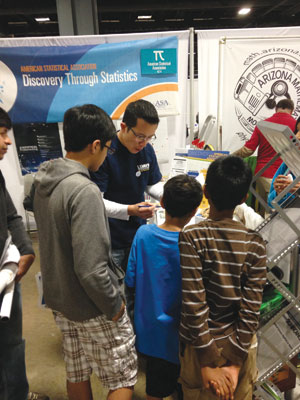WSS Assists with Poster Competition, Festival Booth
Carol Joyce Blumberg and Rebecca Nichols

Zhen Zhang demonstrates the capture-recapture activity with students visiting the ASA booth at the U.S. Science & Engineering Festival.
Washington Statistical Society (WSS) members recently did the preliminary judging for those posters submitted for the national Poster Competition from students residing in areas without a regional competition. In addition, they separately judged posters entered into the Washington, DC, metropolitan area competition.
The judging was coordinated by Barnali Das of Westat with assistance from Marilyn Schenk of Westat and Rebecca Nichols, ASA director of education. The judges were divided into two teams. The first team of Lin Li of Westat, Tiandong Li of Westat, Bruce Murrie of the U.S. Department of Education (retired), Vimal V. Rao of the U.S. Department of Health & Human Services, John Scott of the U.S. Food and Drug Administration, and Richard Sigman of Westat judged the posters at the grades 10–12 level. The other team of Carol Joyce Blumberg of the U.S. Energy Information Administration (retired), Dhuly Chowdhury of RTI International, Brenda K. Edwards of the National Cancer Institute, Gloria Gridley of the National Cancer Institute (retired), and Mark Otto of the U.S. Fish and Wildlife Service judged the projects entered at the K–3, 4–6, and 7–9 levels. The winning entries from each grade level from each competition were forwarded to the national competition.
U.S. Science and Engineering Festival
The ASA booth, Discovery Through Statistics, was one of more than 3,000 exhibits at the biennial U.S. Science and Engineering Festival that was attended by approximately 100,000 people from April 25–27. In addition to the activities described below, the booth had information about K–12 projects and resources (PDF download), careers in statistics, Census at School, and the Statistical Significance series that describes contributions statisticians make to society.
Activities
The first two activities were variations on the winning entries from the ASA 2010 Hands-On Statistics Activity Competition. The third activity was based on the world-wide effort called Census at School. The three activities focused on different aspects of data collection using proper techniques and on graphical methods used to display results.
Parachute Drop: Visitors to the booth dropped parachutes with canopies made from four types of materials. For each drop, they measured the time to reach the ground. They then put stickers on separate dotplots for the recorded flight time for each type of parachute. They also were able to decide which parachute was longest flying based on the dot plots.
Capture-Recapture: Visitors estimated the number of fish in a pond, where a big bowl of beads represented the pond. Certain colors of beads represented the captured/tagged fish and other colors of beads represented the non-tagged fish. Each buy ativan online no prescription needed visitor blindly drew 25 beads from one of the ponds and recorded the number of tagged fish. They then computed the estimated number of total fish based on their sample. They were then able to compare their estimates to those computed by other visitors. In addition, the U.S. Fish and Wildlife Service provided displays showing typical types of markers used to tag fish and other animals.
Census at School: Census at School is an international classroom project that engages students in grades 4–12 in statistical problemsolving using their own real data. One of the major activities of Census at School is to have students complete a brief online survey, analyze their class results, and compare their class with random samples of students in the United States and other countries. For the Science & Engineering Festival, four of the questions were used: gender, age, hours of sleep per night on a school night, and which superpower (invisibility, telepathy, freeze time, super strength, or flying) they would like to have. The visitors to the booth then put stickers (different colors for female and male) on a scatterplot of age versus hours of sleep and on a histogram of superpowers. It was most interesting that the proportions choosing the different superpowers showed a different pattern for females and males based on a sample of more than 200 visitors to the booth.
ASA member Carol Joyce Blumberg and Nichols coordinated the booth, while WSS and the DC chapter of the American Association for Public Opinion Research (DC-AAPOR) provided volunteers to run the activities and assist with questions from visitors. Volunteers included Lin Li of Westat, Bruce Murrie of the U.S. Department of Education (retired), Mark Otto of the U.S. Fish and Wildlife Service, John Scott of the U.S. Food and Drug Administration, Franca Benedicty Barton of The EMMES Corp., Cha-Chi Fan of the U.S. Census Bureau, Walter Hill of St. Mary’s College, Ruth Hummel of the U.S. Environmental Protection Agency, Beth Johnson of George Mason University, Jurate Landwehr of The Sumanim Group, Ruey-Pyng Lu of the U.S. Energy Information Administration, Keshia-Lee Martin of American University (student), Mike Messner of the U.S. Environmental Protection Agency, Chris Moriarity of the National Center for Health Statistics, Martha Dusenberry Pohl of the U.S. Department of Justice (retired), Junshan Qiu of the U.S. Food and Drug Administration, Maria E. Ramos of Bisamer LLC, Marilyn Seastrom of the National Center for Education Statistics, Brian W. Sloboda of the U.S. Department of Labor, Zhiwei Tan of the University of Maryland (student), Lorie Wijntjes of PWC, and Zhen Zhang of Abbott Laboratories.
For further information about ASA educational projects and resources, contact Nichols at rebecca@amstat.org.

















